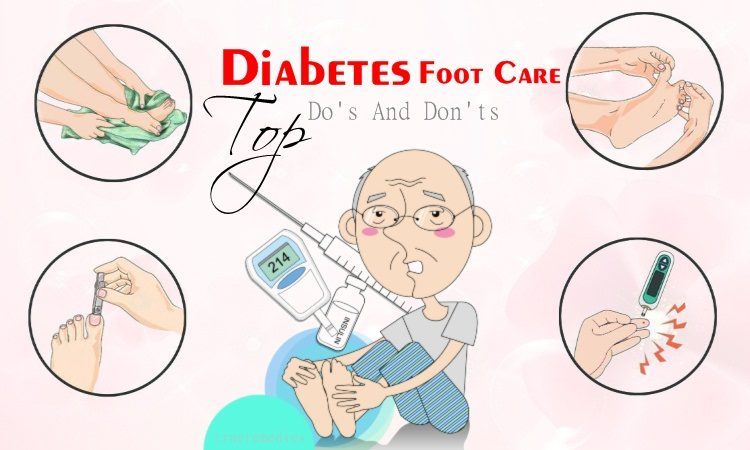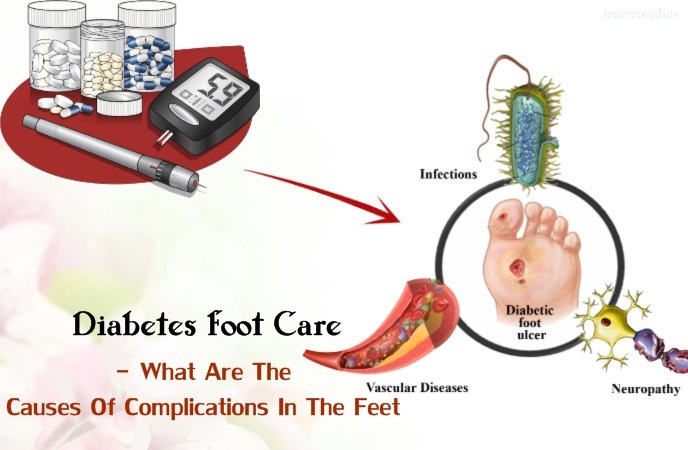Updated: 11/07/2019
Contents
The best thing you can do for your overall health, in general, and your feet, in particular, is to keep blood sugar levels under control. It can prevent nerve damage, or called peripheral neuropathy. Diabetes can be dangerous to your feet because it can cause to lose feeling on your feet, and you don't know when you will get other injuries or sores on them. If you have already suffered from diabetes and nerve damage, controlling blood sugar well and taking care of your feet can prevent further damage. Or, if you take care of people with diabetes, make sure that you are doing all to protect their feet and toes. Also, when putting on or taking off your socks or shoes, inspect your feet for infection signs such as blisters, redness, or pus. If it is difficult for you to see all of your feet, you can use a mirror, or request a family member to examine your feet for you. Today, TrueRemedies will introduce to you the do's and don'ts for diabetes foot care that you should pay attention to!
These 9 Do's And Don'ts For Diabetes Foot Care Helps You Care For Your Feet Properly
I. What Are The Causes Of Complications In The Feet?
1. Peripheral Neuropathy Damage
Diabetes may cause a kind of nerve damage called neuropathy[1] [2] [3] in nearly 70% of diabetic patients. Although researchers don’t yet know the exact cause of this issue, it is thought that excess sugar in human blood causes the cells covering nerve endings to be swollen. This pinches the nerves, leading to lasting damage. It usually happens in people who ignore their blood sugar levels for long or are careless about their health. If blood sugar levels aren't kept it control for a very long period of time then it can lead to neuropathy. So this is counted under macrovascular complications or long term complications.
Therefore, diabetic patients may suffer from tingling, numbness, and even pain in the hands and feet[4].
2. Foot Ulcers
As you may know, foot ulcers are very common in diabetics, and the risks of an ulcer are serious. If you suffer from diabetes, your risk of a foot ulcer at points in your life is about 1 in every 4[5] [6]. Each year in the United States, there are nearly 73,000 lower-leg amputations due to diabetic foot ulcers[7] [8]. Hence, footwear needs to be comfortable and chosen carefully.
This gets a major problem when diabetics don’t care for their feet properly. Patients don't think that they may have a cut, blister, scrape, or injury. Also, poor blood circulation (another sign of diabetes[9]) may prevent the ability of your body to heal the wound. If it gets infected, the foot may develop gangrene, needing an amputation.
TrueRemedies Partner Solutions

Need a Help from the Leading Expert Online, Available 24/7?
They’re all here and ready to answer your questions online or by phone. Keep asking questions until you get the answer you need.
3. Infections
People with diabetes are more susceptible to infections than normal people because of high blood sugar that causes bacteria to grow. Poor blood flow to the feet makes the foot lesions take a long time to heal. Just a small wound can cause ulcers and infections. If the infection is associated with anemia, the risk of amputation is very high.
Foot calluses are often the first sign that can lead to ulcers. If the calluses are red and painful, or the skin of your feet changes color, or the discharge from ulcers has a foul odor, you can suffer from diabetes. Other causes of foot ulcers include:
- Wear shoes, socks that are too tight.
- Diabetics with poor resistance
- Obesity: It increases the pressure on your feet
- Smoking: Tobacco increases the risk of complications in the feet, slowing the absorption of insulin when patients have to inject insulin for treatment. Smokers are two to three times more likely to develop foot ulcers than non-smokers.
II. Common Signs And Symptoms Before Developing Foot Complications
- The toenails are discolored
- Dry skin
- Sensory disorders at the feet
- Pain, tiredness in the legs, which make patients difficult to go far
- Abnormal and prolonged swelling at the feet
- Too many calluses
- Tingling sensation in the feet
- Numbness in the toes
- Crack in the feet
- Any sore doesn’t heal quickly
- Swelling in the feet or legs
III. The Do's And Don'ts For Diabetes Foot Care
In fact, the vast majority of serious complications and amputations in diabetics are avoidable thanks to appropriate patient education, early diagnosis of potential problems, and frequent checkups by a doctor.
You can easily avoid disruptive consequences by starting a good diabetic foot care routine to minimize your risk
1. Do’s
a. Check Your Feet Daily
Check your feet from top to bottom. Or, you can ask a family member to look at your feet if you don't see them clearly. It is necessary to check the skin between your toes and nails to see if there are scratches, calluses, blisters, etc. Check any area of the feet if the skin is dry, red, hot or strained when touching. This needs to be a regular activity. At least once every two days.
Check for the development of toenails to prevent ingrown nails.
b. Clean Your Feet
Use mild soap and warm water (about 37 °C) to wash your feet every day and then gently pat the feet dry.
If the skin of the feet is too dry, use a moisturizer. Apply it to the skin of the feet, especially the heel area. Remember not to apply it to the skin between the toes.
c. Keep Good Blood Circulation
- When sitting, put your feet on another chair
- Do not sit with the legs crossed for too long
- Do not wear tight socks or knotted around the ankles
- Move your toes for 5 minutes 2-3 times per day. Exercise your feet every day to increase blood circulation in your feet, such as walking, cycling, etc. Don’t be seated for a long time. Yoga could be another option to increase blood circulation in the body.
d. Drink Plenty Of Water
Diabetes often causes patients to urine frequently, leading to dehydration. Moreover, drinking plenty of water is a way to cleanse your colon and keep dehydration at bay, all of which are good for diabetics. Therefore, you need to drink plenty of water, more than 2 liters of water/day, to make up for lost water and keep your skin fresh and healthy.
e. Visit A Doctor If Needed
When you have skin lesions or calluses on the feet, you should not handle the issues at home. Instead, you must visit a doctor to check and treat it promptly. Also, the doctor gives you proper guides to care for the skin lesions to avoid more serious complications.
f. Cut The Toenails Horizontally
When you have diabetes, your toenails will be thicker and harder, even curling into the inside of your toenails. Cutting toenails in the usual way can create open wounds, facilitating for bacteria growth to cause an ulcer infection.
To limit this risk, you need to cut the nail in the horizontal line and do not cut toenails too short[10]. You can use a file to smoothen the arch and corner sides of the nails after a trim. You should cut the toenails after bathing because, at this time, the nails are quite soft and easy to cut.
People with diabetes should not treat ingrown toenails at home. Instead, you require help from a doctor or nurse. If you handle it in the wrong way, you are at a high risk of infection.
g. Reduce The Pressure On The Feet
One of the causes of foot complications in diabetics is a decrease in blood supply to the feet. To prevent this, you need:
- Wear flat shoes
- Do not sit cross-legged or for a long time. If you have to travel on a long-distance vehicle, you should occasionally stand up and walk, change your sitting position, or move your legs back and forth to circulate the blood.
- If you have a wound, foot ulcer, or deformed foot, ride a bike instead of walking.
- Massage the soles of the feet in a circle circulation and along the calves and thighs.
2. Don’ts
a. Don't Use The Feet To Test Hot Water
When using hot water to bathe or wash your feet, do not use your feet to check the water temperature because diabetics have a reduction in sensation. Check the water temperature with a thermometer, back of your hand, or elbow. At night, wear socks to keep the feet warm (if it's cold) before going to bed. Do not keep the feet warm with a coal furnace or a hot brick. Avoid using hot water for foot sauna or foot soaks
b. Don't Go Barefoot, Even When You're Inside
Always wear shoes to avoid stepping on sharp pieces of bottles and objects that patients cannot see. Do not wear flip-flops because it can cause ulcers between the big toe and index toe.
Always wear socks to keep the feet warm and protect them. Remember to choose socks made of natural fibers without seams. Replace clean and dry socks every day.
Avoid wearing shoes that are too tight to prevent skin blisters. Always wear shoes with socks to avoid blisters.
It is necessary to check shoes before wearing to make sure there are no objects in shoes, such as dust, insects, etc. to avoid damage to the feet.
Shoe Tips:
- You should own at least two good-quality pairs of shoes so that you can switch them.
- Break a new pair of shoes slowly by wearing them for one hour per day in the first few days.
- Remember to ask your doctor, in case you need to wear special shoes fitted to your feet.
IV. Additional Tips To Prevent Foot Complications
Diabetes can cause many complications that seriously affect the health and life of patients and can cause lifelong disability. Patients must really consider the issue and know how to take care of themselves to actively prevent this complication.
- Have a healthy diet to control blood sugar levels
- Stay active, exercise, and walk every day
- Regularly monitor blood sugar, take medicine, and follow checkup regularly
- Quit smoking
- Check and take care of your feet properly every day and protect your feet with proper socks and shoes and sandals. Don’t consume alcohol, aerated beverages and avoid sugar-free as much as possible.
The above is information on the do’s and don'ts of diabetes. With this article, we hope that it can give you some advice to help patients prevent further illness. If you have any questions about the topic, please contact us immediately by dropping a comment in the comment box. For other articles about the do's and don’ts or related-health issues, please visit our New & Facts page.
Note: See more: 22 Home Remedies For Colon Cleansing Detox. This article was medically reviewed/fact-checked by Dr . Sarah Brewer MSc.











